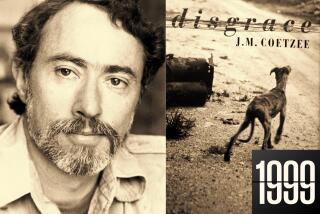Famous and yet unknown
Donna Tartt is a small, tightly wrapped package. Her arms are folded over a black, double-breasted jacket buttoned to the neck; her legs are crossed in a long black skirt, revealing a bit of black hose that quickly disappears into a medium heeled black shoe. Her dark hair is equally severe, bobbed to frame her face, which she frequently turns away even while talking to you. Her skin shows no sign of having seen sun; her eyes are green and ethereal, like light through a stained glass window. Smiling is not her strong suit.
Ten years ago, Tartt published her first novel, “The Secret History,” which she had started writing in college and which sold a million copies in the U.S. and was translated into two dozen languages. And now, after a decade of work, Tartt, 38, has just published her second novel, “The Little Friend” (Knopf), with a huge first printing, 300,000 copies.
Tartt says that she is a slow, meticulous writer, but very quickly you get the idea that maybe she produces a novel only every decade or so because she dislikes the book tours that come with celebrity. “Our Reticent Hero,” one Web site devoted to Tartt calls her.
Rather basic biographical facts, for example, such as whether she is married, are off limits.
“I don’t like to talk about my personal life,” she says, sitting in a chair in the corner of a hotel lobby.
Why?
“Why should I?” she asks, well, tartly.
Personal publicity, Tartt explains, is not just annoying; it’s actually injurious to a writer.
“It’s detrimental,” she says. “It’s actively harmful. It draws attention away from the books. The books are the important thing. I think that a writer’s life is very unimportant. The book is the important thing. I’m not an actress; it’s not my job to present myself as myself. Books are objects that stand on their own. There’s too much interest in text being interpreted in terms of the writer’s own or imaginary biography. Hemingway is a really good example. People think that they’ve got Hemingway’s number, that they know who he is, so they don’t bother to read his books anymore. Hemingway’s life was not the interesting or important thing about him; it was his books, that’s what he did.”
Yet Tartt is no slouch at carefully crafting an image, always smartly turned out, as fastidious in appearance as in print. She lounged like a rather stern-looking odalisque (in riding boots and holding her dog) for a photo in Newsweek recently and so great was the buzz stirred up by the bidding war for her first book that Vanity Fair sent a writer with Tartt back to Grenada, Miss., where she grew up, for a fawning profile.
Tartt is the elder of two daughters of a service station owner-cum-local politician; she started writing poetry at 5 and began publishing in literary reviews in her teens. In Tartt’s telling, reading was always in the air at home, like the scent of magnolia. A great-aunt and an aunt were librarians, and Tartt worked in the public library as a high school student.
“We just all read,” she says. “It was just something in the culture of my family. I didn’t know other children who read.”
Tartt went to the University of Mississippi in Oxford, where she wanted to write for the school newspaper but didn’t have any clips. She submitted a few short stories. The editor passed them to Willie Morris, a member of the New York literati and former editor of Harper’s who was a writer-in residence at Ole Miss. He became a mentor, urging her to transfer to Bennington College in Vermont. There Tartt started writing the novel that became “The Secret History,” about an elite group of classics students at a New England school a lot like Bennington who kill a farmer and then one of their own.
“If I had had the money, I probably would have gone on to graduate school and become an academic,” Tartt says. “So it’s probably a good thing that I didn’t have the money.”
Instead, after almost a decade of work, she finished the novel. Author Bret Easton Ellis (“Less Than Zero”) was a close friend from Bennington, and he introduced Tartt to his agent, Amanda Urban, at Creative Management. Before long, Tartt had sold the hardcover and paperback rights for close to a million dollars.
“The Secret History” was a huge success but, except for a few magazine pieces, Tartt largely dropped out of sight for the next decade. “Ten years of mysterious silence,” as Vanity Fair put it recently.
Not so mysterious, Tartt says. She was just working, either in her house near Charlottesville, Va., or in her New York apartment.
“I write pretty slowly,” she says. “It’s part of every author’s job to decide one’s own pace and not to pay too much attention to other people’s expectations. When I start something, I don’t ever think of how long it will take me or I’d probably never start in the first place.”
“The Little Friend,” like its predecessor, begins with a death. This time it’s the mysterious hanging of a 9-year-old boy named Robin from a tree in his family’s yard in Mississippi. A dozen years later, in the 1970s, his sister Harriet, who was an infant at the time of his death, decides to solve the murder -- if that is what it was. Although the book builds to moments of suspense, “I’m not interested in murder so much as questions of guilt and culpability and the echoes of murders and evil throughout time,” Tartt says.
“A line from Sophocles that I think of again and again is, ‘If evil shall lead to evil where shall the chain of evils end?’ That’s what interests me most about murder, and it doesn’t even have to do with murder but moral wrong. I’m not interested in detectives or mysteries or thrillers in the conventional sense. If people read my books thinking they’re getting a conventional mystery or thriller, they’re going to be disappointed, because that’s not what I do at all.”
‘Vitally interested’ in writing
What Tartt has done is to create a vivid world, populated by well-developed characters, especially Harriet, the bookish, smart, headstrong 12-year-old whose description even sounds like Tartt. Although Tartt says she had no idea it would take so long to write the book, it doesn’t sound as if she regretted a moment of it.
“One has to really want to come back to it again and again,” she says. “You can’t fake interest in something for 10 years. You have to be vitally interested in it. One hopes that something of one’s own interest, of that obsession, will come itself to the reader.”
That largely has not been a problem. The book has hovered at the top of The Times’ bestseller list since its publication in October, and most reviews have been adoring. “Tartt’s second novel confirms her talent as a superb storyteller, sophisticated observer of human nature and keen appraiser of ethics and morality,” Publishers Weekly wrote.
A couple of critics have carped that, at close to 500 pages, the novel takes almost as long to read as it did to write. “Lacks all the seductive, page-turning thrills of its predecessor,” complained the Seattle Times. “The story has moments of suspense,” the L.A. Times’ review said, “but they are undermined by a basic sluggishness.”
Tartt’s next book shouldn’t take nearly so long to write. She was commissioned to write a novella, a modern retelling of a classic myth. She picked the story of Daedalus, the inventor who built the labyrinth for King Minos.
“It’ll be interesting to write something short,” she says. “And to be somewhat bounded by the actual story I have. The story is already there. The treatment and angle at which one sees it is new. It won’t require a lot of planning. The Greeks already did that for me.”
Tartt won’t discuss her idea for the recasting. “I don’t really want to talk about the treatment,” she says. “It’s not going to be set in ancient Greece. But I’m really interested in the forms and idioms of Greek tragedy, which are strangely ambiguous and unsettled. Sophocles’ tragedies are very open-ended and modern; they’re not tidily summed up.”
And she’s already at work on her next big novel, although don’t even try to pry any details out of her. “Personally, I’d just have people read the book,” she says. “I don’t have that much to say that’s not contained within my books. One wants, above all, one’s book to be read.”
Then Tartt uncurls herself from her chair and stands up, topping 5 feet in heels, and runs off to a bookstore reading.
“Giving readings is completely different,” she says. “I love to read in public. That part is enjoyable.”
More to Read
Sign up for our Book Club newsletter
Get the latest news, events and more from the Los Angeles Times Book Club, and help us get L.A. reading and talking.
You may occasionally receive promotional content from the Los Angeles Times.






